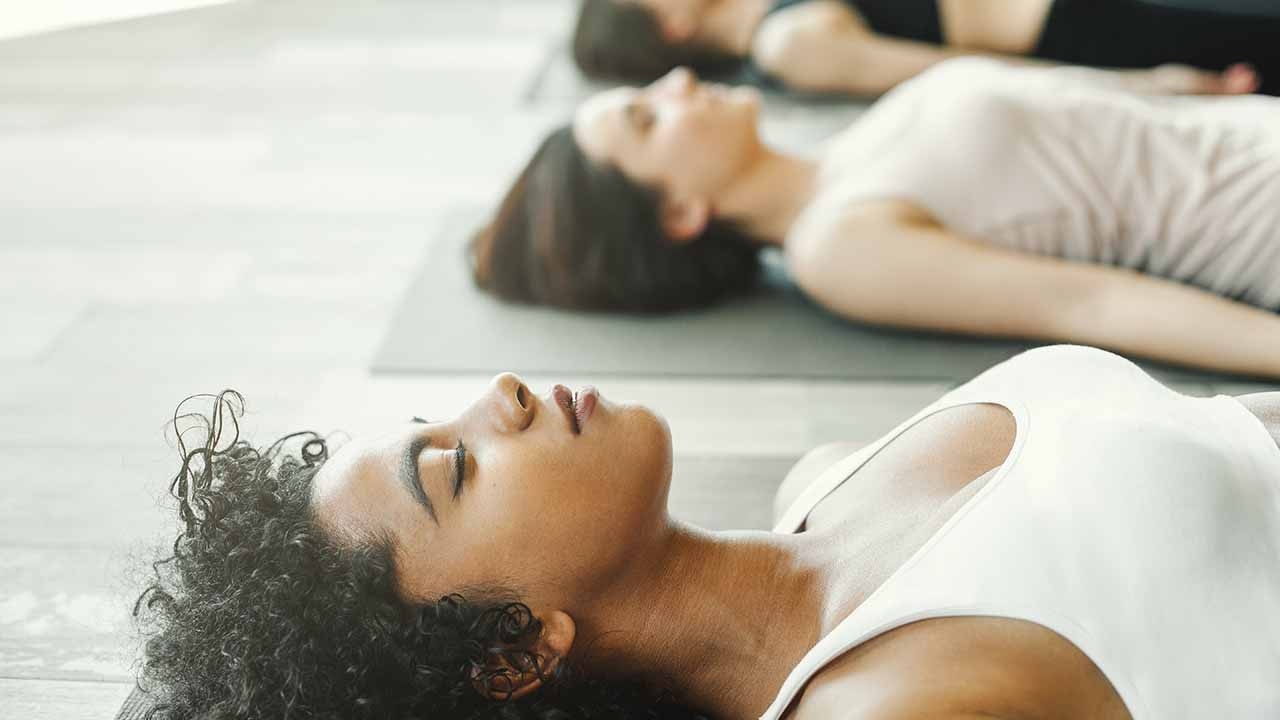What's Yoga Nidra?

Yoga Nidra, or yogic sleep, is an ancient powerful type of meditation that is said to bring you to a point between being awake and asleep. Giving you similar benefits to deep sleep, Yoga Nidra helps alleviate stress and anxiety, reduces negativity, promotes relaxation and restoration, improves sleep, and encourages feelings of wholeness, wellbeing and belonging. It's also said to have the potential to heal psychological wounds and has begun to get more attention from Western science in recent years because of all these benefits.
There are a series of stages to Yoga Nidra that are consistent every time you do it, and a Nidra session typically lasts around 20-40 minutes (though a brief one could be done in as little as 10 minutes). It's guided by a yoga teacher who gives you instructions throughout the session.
The intention is not for you to actually fall asleep, though some people do as it's incredibly relaxing! There is no right or wrong when it comes to Yoga Nidra - if you do fall asleep, your ears are still hearing the instructions and your brain can still absorb the benefits.
The best part is that anyone can do it, and it's perfect for those who want to experience meditation but struggle to do it on their own.
This is an outline of a full Yoga Nidra session, however, sessions may not always include every step below.
Internalisation (settling in)
It's important that you are as comfortable as possible, so when you're setting yourself up in Svasana, be mindful of positioning your body, the temperature of the room, any noises you can hear that may interrupt your, and covering yourself with a jumper and/or blanket in case you get cold.
From here, you can settle into fully relaxing your body and releasing any remaining tension; begin to take deep even breaths. The final part of settling in is drawing inwards through awareness of the senses - noticing the feeling of the ground underneath you, tastes, smells, and any sounds from those farthest away and progressively working towards you until your focus is on the sound of your own breath. Notice any emotions or thoughts that come up without judgement, passing from one to the next without dwelling on them.
Set a sankalpa
A sankalpa is a resolve, an intention that you want to carry into your Yoga Nidra practice ahead (and also into the outside world). It should be brief, specific, positive and in the present tense - such as 'I am happy', 'I am relaxed', or 'I am brave'. This is typically repeated three times in your mind.
Body scan
All parts of the body are acknowledged one at a time - just observing without moving them - in a rotational scan. Initially individual body parts are addressed, followed by areas (such as the left side, the right side, the whole body).
Breath and energy awareness
This step gets us to acknowledge our breath, notice what it's doing, and also pay attention to inner sensations of energy inside the body.
Opposites
Opposite emotions or sensations are suggested such as anger/peace, fear/courage, which links with the part of our brain that processes perspective and insight for the emotions that are brought up. Life incorporates all of these emotions - both sides - so this step helps us notice and respond to them all in a healthier way (including those that challenge us). Yoga Nidra is being studied for its potential to help people with PTSD; this stage of Nidra particularly needs to be guided with care for people who have experienced severe emotional trauma.
Visualisations
Image suggestions are given for you to visualise, and these can vary depending on the intention of the meditation and the teacher. Visualisation is a very powerful tool - when we visualise doing something, it can activate the same parts of the brain as if we were physically doing the activity.
Sankalpa repetition
Towards the end of Yoga Nidra, we repeat our sankalpa - or intention - that we set at the beginning. This is to further cement it in our subconscious and conscious mind, so we can take it away with us when we leave our mat.
Externalisation
Once Yoga Nidra is complete, you will be slowly guided back to the 'outside world'. Feeling the ground underneath your body, introducing small movements back into it, and slowly coming up to a seated position again.
Reflection
Following the Yoga Nidra practice it's normal to feel a little sleepy or odd. You may feel nothing different, or it may have encouraged feelings or emotions to the surface. Observe them but don't worry about over-analysing your response! It's also common to not remember what happened, but feel like you want more of whatever 'it' was.
REFERENCES:
- https://www.scientificamerican.com/article/can-visualizing-your-body-doing-something-help-you-learn-to-do-it-better
- Transforming trauma: a qualitative feasibility study of integrative restoration (iRest) yoga Nidra on combat-related post-traumatic stress disorder. https://www.ncbi.nlm.nih.gov/pubmed/22398342
Image / DepositPhotos









